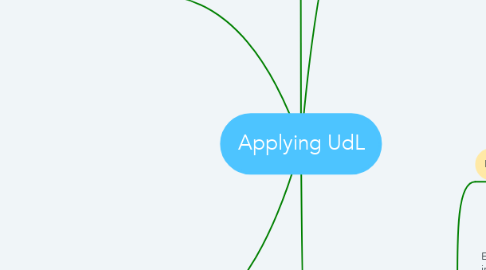
1. UDL Principle: WHAT/Multiple Means of Representation
1.1. Rubric Element: Present Your Lessions
1.2. Clarify vocabulary: Preteach vocabulary
1.2.1. Highlight how complex terms and expressions are composed
1.2.1.1. Example: Numerator, denominator
1.3. Guide information processing: Give explicit prompts for each step in a sequential process
1.3.1. Example: step 1,Fold paper in half, step 2, color one side of the paper, etc.
1.4. Use symbolic representation and concrete or virtual manipulatives
1.4.1. Example: Present key concept of fraction equivalents with an alternative form such as an illustration, model, or animation
1.5. Highlight big Ideas
1.5.1. Example: Demonstrate examples and non-examples of equivalent fractions with Geoboards, folding paper exercise, and drawing diagrams
1.6. Customize the display of information
1.6.1. Example: When using tablets ensure students who use of high contrast display and text size when needed
2. HOW/Multiple Means of Action and Expression
2.1. Rubric: Demonstrate Comprehension
2.2. Expression is used by utilizing multiple media for communication
2.2.1. Examples
2.2.1.1. Use whiteboards and manipulatives
2.2.1.2. Use Geodot paper
2.2.1.3. Use Geoboard application on smart tablets
2.2.1.4. Fold paper and using crayons or markers to shade parts of the paper to show equivalents
2.3. Expression is demonstrated with various methods for responding
2.3.1. Examples
2.3.1.1. Folding
2.3.1.2. Cutting
2.3.1.3. Coloring
3. Unit Lesson: Understanding Fraction Equivalence and Ordering - CCSS>MATH>CONTENT.4.NFA.1
4. References
4.1. National Center on Universal Design for Learning. (2018). The Three Principles of ULD. Retrieved on August 9, 2018 from http://www.udlcenter.org/aboutudl/whatisudl/3principles
4.2. Kentucky Department of Education. (2018). Universal Design for Learning. Retrieved August 9, 2018 from https://education.ky.gov/educational/diff/Pages/UDL.aspx
4.3. Common Core Standards. (2018). Grade 4 Number & Operations_Fractions. Retrieved from http://www.corestandards.org/Math/Content/4/NF/
4.4. Wiggins, G. P., & McTighe, J. (2005). Understanding by Design. Alexandria, VA: Assoc. for Supervision and Curriculum Development.
5. WHY/Multiple Means of Engagement
5.1. Rubric: Motivate or Engage
5.2. Engagement is demonstrated by optimizing individual choice and automony
5.2.1. Examples
5.2.1.1. Allow choice of makers or crayons and color
5.2.1.2. Allow recording of answers to discussions on paper or tablets or computer
5.2.1.3. Allow students to answer assessment question in words, numbers or symbols
5.3. Engagement is present by fostering collaboration and communication
5.3.1. Examples
5.3.1.1. Class discussion of examples of equivalent and nonequivalent fractions
5.3.1.2. Working in groups to do activity of folding paper in different fractions
5.3.1.3. Allow time for students to explore Geoboards, Geodot paper, tablet applications
